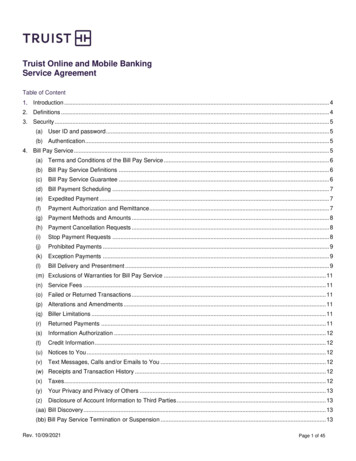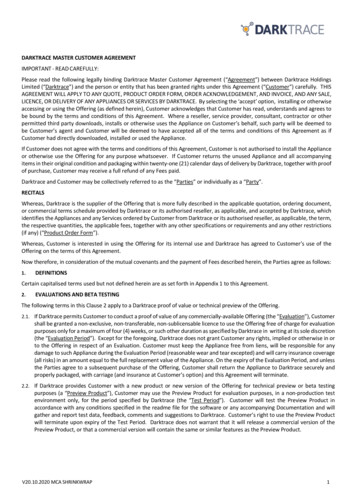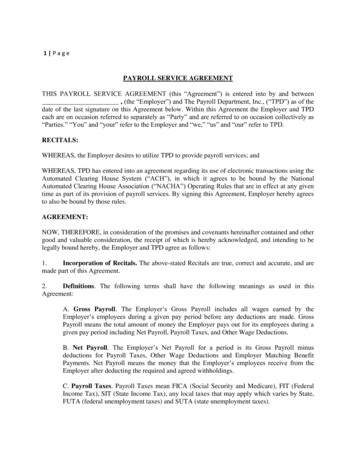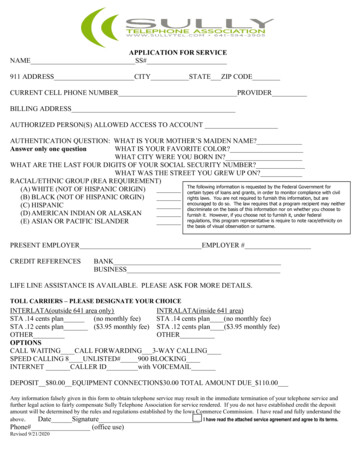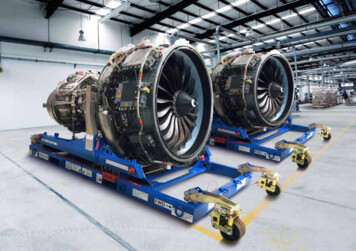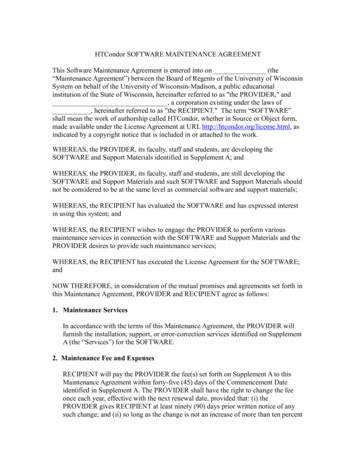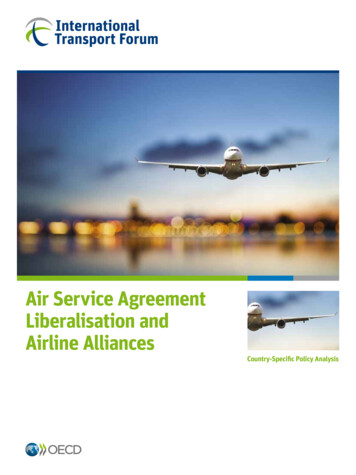
Transcription
Air Service AgreementLiberalisation andAirline AlliancesCountry-Specific Policy Analysis
Air Service AgreementLiberalisation andAirline AlliancesCountry-Specific Policy Analysis
INTERNATIONAL TRANSPORT FORUMThe International Transport Forum at the OECD is an intergovernmental organisation with 54 membercountries. It acts as a strategic think tank with the objective of helping shape the transport policy agenda on aglobal level and ensuring that it contributes to economic growth, environmental protection, social inclusionand the preservation of human life and well-being. The International Transport Forum organises an AnnualSummit of ministers along with leading representatives from industry, civil society and academia.The International Transport Forum was created under a Declaration issued by the Council of Ministersof the ECMT (European Conference of Ministers of Transport) at its Ministerial Session in May 2006 underthe legal authority of the Protocol of the ECMT, signed in Brussels on 17 October 1953, and legalinstruments of the OECD.The Members of the Forum are: Albania, Armenia, Australia, Austria, Azerbaijan, Belarus, Belgium,Bosnia and Herzegovina, Bulgaria, Canada, Chile, People’s Republic of China, Croatia, Czech Republic,Denmark, Estonia, Finland, France, Former Yugoslav Republic of Macedonia, Georgia, Germany, Greece,Hungary, Iceland, India, Ireland, Italy, Japan, Korea, Latvia, Liechtenstein, Lithuania, Luxembourg, Malta,Mexico, Republic of Moldova, Montenegro, Netherlands, New Zealand, Norway, Poland, Portugal,Romania, Russian Federation, Serbia, Slovak Republic, Slovenia, Spain, Sweden, Switzerland, Turkey,Ukraine, United Kingdom and United States.The International Transport Forum’s Research Centre gathers statistics and conducts co-operativeresearch programmes addressing all modes of transport. Its findings are widely disseminated and supportpolicy making in Member countries as well as contributing to the annual summit.Further information about the International Transport Forum is available s work is published under the responsibility of the Secretary-General of the International TransportForum. The opinions expressed and arguments employed herein do not necessarily reflect the official viewsof International Transport Forum member countries.This document and any map included herein are without prejudice to the status of or sovereignty over any territory, to thedelimitation of international frontiers and boundaries and to the name of any territory, city or area.
AcknowledgementsThe analysis for this report was undertaken by InterVISTAS Consulting Inc. The InterVISTAS team comprisedMichael Tretheway, Howard Mann, Kate Markhvida, Ian Kincaid, Luciano Nunes and Buddy Anslinger. WouterDe Wit at the International Transport Forum contributed Annex A of the report and the aviation team at the ITFreviewed and completed the analysis.AIR SERVICE AGREEMENT LIBERALISATION AND AIRLINE ALLIANCES OECD/ITF 2014
TABLE OF CONTENTS –Table of contentsEXECUTIVE SUMMARY1.9INTRODUCTION. 111.1 Purpose . 111.2 Outline . 122.2.12.22.32.4BILATERAL AIR SERVICE AGREEMENTS . 13Major Provisions of ASAs . 13Major Provisions of Open Skies Agreements . 14Ownership and Control Provisions . 17Summary of Selected, Trend Changing U.S. ASAs . 223.AIRLINE ALLIANCES. 313.1 General comments on Airline Alliances . 313.2 Linkages between ASAs and Airline Alliances . 334.THE EFFECTS OF LIBERALISED ASAS AND IMMUNISED AIRLINE ALLIANCES . 374.1 The Impacts of ASAs Liberalisation . 374.2 The Impact of Immunised Airline Alliances . 414.3 Stakeholder Acceptance Issues . 435.COMPETITION REVIEW OF AIRLINE ALLIANCES . 47Key Issues with Reviewing and Authorising Airline Alliances . 47Remedies . 52Institutions Involved in Authorising Alliances in Selected Jurisdictions . 57Legal and Regulatory Framework in Selected Jurisdictions . 60International Competition Authority Co-operation? . 625.15.25.35.45.5ANNEX A. The impact of alliances on social welfare: . 67A.1 Introduction . 67A.2 Alliance between airlines with complementary networks. 67A.3 Alliances between airlines with partly overlapping networks . 68A.4 Theoretical assessment of implications of alliances on social welfare . 69A.5 Empirical assessment of implications of alliances on social welfare . 69A.6 Extension 1: Real life networks . 70A.7 Extension 2: Antitrust immunity . 71A.8 Extension 3: Merger . 71A.9 Conclusion . 72ANNEX B. List of abbreviations . 73ANNEX C. U.S. Airline alliances with antitrust immunity . 74ANNEX D. Freedoms of the air . 75BIBLIOGRAPHY . 79AIR SERVICE AGREEMENT LIBERALISATION AND AIRLINE ALLIANCES OECD/ITF 20147
8 – TABLE OF CONTENTSFigures3.1 Common Types of Airline Alliances . 324.1 Traffic Growth (%) in first year following ASA liberalisation . 371.A1. Network structure in simplest form . 682.A1. Expanded network structure . 693.A1. Combined interline market network . 71Tables2.1. Ownership and Control Requirements in Selected Countries (current as of 2001) . 194.1. Liberalisation of U.S. Bilateral ASAs and Traffic Growth . 385.1. Selected US DOT Immunised Airline Alliances - Summary . 55AIR SERVICE AGREEMENT LIBERALISATION AND AIRLINE ALLIANCES OECD/ITF 2014
EXECUTIVE SUMMARY –9Executive SummaryThis document explores the key elements of bilateral air service agreements (ASAs) and recent trendstowards increasing liberalisation and examines linkages between ASAs and cross border airline alliance.It discusses issues related to antitrust reviews of proposed alliances and summarises and comments onthe impacts of international airline alliances.The conventional wisdom is that liberalisation of air services between countries generates significantadditional opportunities for carriers, consumers, shippers, and the numerous direct and indirect entitiesand individuals affected by such liberalisation. Conversely, restrictive bilateral air service agreementsbetween countries stifle air travel, tourism and business and, consequently, economic growth and jobcreation.The report reviews a number of studies that have documented the empirical effects of liberalisation of airservices. One of the main findings is that, on balance, there is strong evidence that liberalisation ofbilateral air service agreements leads to substantial benefits for carriers, travellers/shippers andeconomies in general. Even liberalising bilateral air service agreements in an incremental fashion cangenerate significant benefits.The analysis shows, among other results, that just one year after the liberalisation of individual bilateralagreements involving the United States, traffic increased by as much as 174%. On average the increasewas roughly a doubling of traffic. Similarly, a 2002 report prepared for the European Commission foundthat, on average, passenger traffic annual growth rates increased from 4.4% in the years prior to an openskies agreement between a European country and the U.S., to 7.8% in the years following the signing ofan open skies agreement. In comparison, transatlantic markets not subject to an open skies agreementsaw no notable change in growth rates over the same period.A study by the World Trade Organization (WTO), with data on passenger flows between 184 countries,also examined the impact of liberalisation on traffic volumes. The analysis found that complete or nearcomplete liberalisation resulted in traffic increases of 30%, on average, although some impacts were ashigh as 86% on some country pairs.Positive effects on fares have also been identified. For example, a 2000 study by the U.S. Department ofTransportation found that fares on routes with an open skies agreement between the U.S. and a Europeancountry had declined by 20.1% between 1996 and 1999, while fares on routes subject to a non-open skiesbilateral agreement had declined by only 10.3%.Oum, Zhang and Fu (2010) investigated the impacts of liberalisation on traffic volume and patterns, aswell as on economic growth. In addition, they examined the underlying mechanisms leading to thoseimpacts. The authors found that liberalisation increases route competition and airline efficiency, whichreduced prices and increased both quality of service and traffic volumes. The latter, in turn, boosts jobcreation and economic growth.AIR SERVICE AGREEMENT LIBERALISATION AND AIRLINE ALLIANCES OECD/ITF 2014
10 – EXECUTIVE SUMMARYThe evidence regarding the effects of antitrust immunised alliances is more mixed but, in general, theempirical literature finds that most alliances produce benefits to both the allied carriers and theconsumers. Airline alliances are cooperative arrangements between airlines, ranging from interlineagreements to highly integrated forms of cooperation such as metal-neutral revenue sharing jointventures. An important benefit enabled by an alliance is access to traffic that in the absence of thealliance would not be possible, due to limitations established by bilateral ASAs or national laws.Alliances have greatly benefited consumers in connecting markets, both by lowering the average farethey pay and by reducing the time required for their journey. The value of time for airline travellers issuch that the time saving benefits are very substantial. The fare benefits derive in part from reducing thedouble marginalisation that arises when unallied carriers independently determine the price for differentsegments of an interline trip.Online connections also mean that passengers do not have to transfer to other airlines, which greatlysimplifies baggage transfers, ticketing, check-in procedures and schedule coordination, producing furtherbenefits for consumers. Other positive effects from alliances for passengers, documented in variousstudies, include expanded number of destinations for travellers, lower fares for connecting passengers ininternational markets and an increase in passenger traffic stimulated by lower fares.Another key finding of this study is that there is a nexus between liberalised ASAs and anti-trust allianceauthorisation. Competition authorities review alliances on a case by case basis to determine what impactsthey have on competition in the marketplace. If net impacts are positive, alliances are typically approvedand granted antitrust immunity.A central issue for competition agencies in reviewing and authorising an agreement between airlines isthat there must be low entry barriers into the markets. To the extent that a bilateral air service agreementrestricts access to add or expand air service for existing and potential airlines, it may pose a substantialbarrier to entry, fostering the undesirable consequences of an alliance, such as price increases.While liberalised or open-skies’ ASAs generally do not include stipulations for authorising airlinealliances, their provisions change market conditions in such a way that some or most competitionauthority requirements regarding alliances can be achieved, which facilitates authorisation.The second significant potential barrier to entry is limited access to take-off and landing slots at airports.This issue was raised in several reviews by competition authorities of alliances and cross-border mergers.Slot access, however, needs to be reviewed in the context of a particular alliance and with respect tospecific routes operated by that alliance.Remedies that are typically applied by competition authorities to approved alliances include thefollowing: carve outs; carriers may be required to relinquish take-off and landing slots or make themavailable for lease to competing airlines at airports with restricted capacity; withdrawal fromconsultations or participation in negotiation of fares, rates and charges through IATA; limits to durationof alliances.AIR SERVICE AGREEMENT LIBERALISATION AND AIRLINE ALLIANCES OECD/ITF 2014
1. INTRODUCTION –111. Introduction1.1 PurposeThe objective of this report is to provide an overview of the key principles and issues underlying bilateralair service agreements (ASAs) and the authorisation of cross border airline alliances, so it helps guidepublic policy given the observed global trend towards both liberalising ASAs and establishing wider anddeeper networks by carriers.Bilateral air service agreements (often called ASAs, bilaterals and occasionally ATAs for air transportagreements) have been around almost as long as flight itself. As flying became more popular and airlinesexpanded their service, nations around the world and their associated airlines realized the need for airservice agreements to facilitate the provision of international air service, protect their airlines againstunfair foreign competition and to create new opportunities for those same airlines outside the borders oftheir home country.Prior to liberalised ASAs and particularly open skies agreements, ASAs tended to be lengthy documentswhich regulated every aspect of international air service, including number of carriers, seat capacity,routes and fares.Liberalisation of international air services is widely believed to generate significant additionalopportunities for carriers, consumers, shippers, and the numerous direct and indirect entities andindividuals affected by such liberalisation. Conversely, restrictive bilateral air service agreementsbetween countries stifle air travel, tourism and business and, consequently, economic growth and jobcreation.According to ICAO, as of October 2012 there were 400 liberalised agreements involving 145 states. Anumber of studies have documented the empirical effects of liberalisation of air services. One of the mainfindings is that, on balance, there is strong evidence that liberalisation of bilateral air service agreementsleads to substantial benefits for carriers, travellers/shippers and economies in general. Even liberalisingbilateral air service agreements in an incremental fashion can generate significant benefits.International airline alliances originated in part as a way to overcome the barriers to entry posed byASAs. In network planning, international airlines often envision a route structure which includes routesbetween their home country and another, and often times, routes beyond that country to a third country.However, airlines are required by most bilaterals to abide by the route rules established for their nation,which sometimes preclude them from serving points they would like to do so. By forging an alliancewith another carrier, an airline can expand its network and provide customers with many more itinerarycombinations than it could on its own.Although airline cooperation in one form or another stretches back decades, including co-branding andinterline relationships, the 1992 signing of the open skies agreement between the U.S. and theNetherlands heralded a new age of airline alliances which has encompassed many countries.AIR SERVICE AGREEMENT LIBERALISATION AND AIRLINE ALLIANCES OECD/ITF 2014
12 – 1. INTRODUCTIONPrior to forming an alliance, partner carriers would typically seek antitrust immunity or other forms ofauthorization in jurisdictions where competition in the provision of air transport services may be affectedby the alliance. Institutional frameworks as well as legal and regulatory regimes that govern reviews andapprovals of airline alliance differ from one jurisdiction to another.In reviewing and authorizing an airline alliance, antitrust agencies weigh its pro-competitive benefitsagainst anti-competitive effects. Competition from other airlines may be limited if there exist highbarriers to entry on a given route. In airline markets, the two key barriers to entry have been, at varioustimes and places, constraints on rights to operate commercial air services contained in bilateral air serviceagreements and limited access to airport capacity (slots).Although liberalised or open-skies’ ASAs generally do not include stipulations to authorise airlinealliances, their provisions revise market conditions in such a way that some or most competitionauthority requirements regarding alliances can be achieved, which facilitates the formation of the latter.Often regulators have also applied remedies to ensure that air service markets remain competitive whenauthorising airline alliances, which may range from airport slot divestitures to carving out certain routesfrom alliance authorisation, to requiring allied carriers to provide access to competitors to their frequentflyer programs.In general, the empirical literature finds that most authorised alliances have produced benefits to both theallied carriers and the consumers. Alliances have benefited consumers in connecting markets by loweringthe average fare they pay and by reducing the time required for their journey. Further benefits includesimplified baggage transfers, ticketing and check in procedures, as well as schedule coordination.1.2 OutlineThis report is structured as follows:Section 2 reviews the typical elements of an ASA, describes the elements specific to open-skiesagreements and analyses the recent trend towards liberalising ASAs, with an emphasis on the USexperience.Section 3 studies the rationale behind airline alliances and discusses the linkages between ASAs andinternational airline alliances, focusing on provisions in liberalised and open-skies bilateral ASAs thatfacilitate the formation of alliances.Section 4 summarises findings on the impact of liberalised ASAs and immunised international airlinealliances on passenger traffic, fares and service levels in international markets.Section 5 identifies key elements of antitrust reviews of airline alliances, and contrasts the institutional,legal and regulatory frameworks of selected jurisdictions for reviewing and authorising internationalairline alliances .Appendix A, B, C and D provide additional information to support the main findings in this report.AIR SERVICE AGREEMENT LIBERALISATION AND AIRLINE ALLIANCES OECD/ITF 2014
2. BILATERAL AIR SERVICE AGREEMENTS –132. Bilateral Air Service Agreements2.1 Major Provisions of Air Service AgreementsBilateral air service agreements (often called ASAs, bilaterals and occasionally ATAs, for air transportagreements) have been around almost as long as flight itself. In 1913, Germany and France exchangeddiplomatic notes to establish traffic and service guidelines for airship service between the nations 1. Asflying became more popular and airlines expanded their service, nations around the world and theirassociated airlines realized the need for air service agreements to facilitate the provision of internationalair service, protect their airlines against unfair foreign competition and to create new opportunities forthose same airlines outside the borders of their home country. Bilateral agreements were often writtenwith the intent to protect the flag carriers of the two nations, and diplomatic missions often went to greatefforts to craft an agreement most favourable to their sides, resulting in very detailed and lengthyagreements.Ultimately, in 1944, the Convention on Civil Aviation (the Chicago Convention), created an organizationunder the umbrella of the United Nations to establish rules and guidelines on civil aviation and itstreaties. This organization, the International Civil Aviation Organization or ICAO, does not make thetreaties or even write them, but it has created a framework for treaties and an operating environment forairlines to safely operate international commercial air service.Prior to open skies agreements, ASAs tended to be lengthy documents which regulated every aspect ofinternational air service, including number of carriers, seat capacity, routes, fares and in a few cases, cityticket offices and even aspects of service quality such as sandwich size.Open skies agreements seek to provide broad opportunities for carriers and in the process streamline theASA document. These treaties typically allow the free market to establish prices, routes and capacity, aswell as the number and identity of carriers providing service. In fairness, there are a number of ASAsthat predated open skies agreements that contain all the same articles; it is really the language in thesections dealing with fares, capacity and destinations that the laissez faire attributes of open skiesdifferentiates the two types of bilateral agreements.The United States undertook a major review of its domestic airline and aviation policy and enacted theAirline Deregulation Act in 1978 which eliminated the regulation of fares, routes and schedules indomestic markets. The U.S. saw the success of domestic deregulation and wanted a similar free marketapproach to international aviation; however, international services were regulated by complicatedbilaterals. A change in those bilaterals required approval by foreign nations, and thus the U.S. could notunilaterally impose its will. The U.S. policy was to seek like-minded countries, such as the Netherlandsand later the U.K., and to put in place agreements which provided a greater role for the market in makingdecisions on fares, capacity, etc. Eventually, this process resulted in an archetypical open-skiesagreement, with the U.S. seeking to sign such agreements with as many nations as possible, eventually1Cambon, J. & von Jagow, “Exchange of Notes between France and Germany Concerning AerialNavigation.” American Journal of International Law, Vol. 8, No. 3, July, 1914, pp. 214-217.AIR SERVICE AGREEMENT LIBERALISATION AND AIRLINE ALLIANCES OECD/ITF 2014
14 – 2. BILATERAL AIR SERVICE AGREEMENTSsqueezing reluctant trading partners into an open regime. The fundamental principles underlying openskies agreements and the key provisions included in such agreements are discussed in the next section.2.2 Major Provisions of Open Skies AgreementsThis progressive concept of open-skies agreements pioneered by the United States eliminated all thecomplicated language and rules of the typical bilateral ASA and replaced it with simple prose giving thetwo countries’ airlines the right to fly where and when they want between the two nations (and beyond)and to set their own fares accordingly.2The first formal move toward international open skies occurred in 1979 with the U.S. International AirService and Competition Act. While the success of this initiative was limited, the liberal thinking itembodied was revolutionary in the regulation-heavy world of international civil aviation at that time. Itwasn’t until 1992 that the U.S. signed its first true open skies agreement with the Netherlands, awatershed event in the move to open skies. Shortly thereafter, Northwest Airlines and KLM applied forand received antitrust immunity, and many of today’s industry standards in international cooperationwere established. The Netherlands was the first major country, albeit small, to accept an open skiesagreement with the U.S., and it opened the door for many other European and Asian countries torenegotiate their bilaterals with the U.S. and replace them with the open skies model. The U.S.Netherlands open skies treaty was notable not only for deregulation of the market, but also in that itenabled a major alliance between carriers of different countries. The nexus of ASAs and Alliances wascreated here.Today, the U.S. has entered into 113 open skies agreements with other nations. In addition, othercountries, most notably the member states of the European Union, have embraced the open-skiesconcept, creating an open market in Europe and open skies bilaterals with a number of other nations.New Zealand, Singapore and Brunei have taken open skies furthest, codifying the principle in amultilateral agreement (MALIAT) that grants signatories extensive freedoms of the air.3A “model” U.S. open-skies agreement consists of 17 articles, covering the same scope as theconventional bilateral ASA that predated open skies. The model agreement covers both passenger andcargo air transportation and includes the following subjects: Definitions – clarifies key terms in the agreement. This is a standard section in both types of airservice agreements, open skies and pre-open skies. Grant of Rights – provides routes, destinations, intermediate points, beyond points, etc. Thissection differs from previous bilaterals because it provides almost complete freedom for theairlines to fly to and from where they want in another nation, stopping where they want (e.g.,intermediate points), and flying beyond the country, to a third nation, if desired, but stoppingshort of cabotage.2It is recognized that other nations also pursued open skies type of agreements, such as that between theU.K. and the Netherlands. Individual countries such as Chile and Singapore were also seeking more openregimes.3Multilateral Agreement on the Liberalisation of International Air Transport. New Zealand is thedepository state for the agreement.AIR SERVICE AGREEMENT LIBERALISATION AND AIRLINE ALLIANCES OECD/ITF 2014
2. BILATERAL AIR SERVICE AGREEMENTS –15 Authorization – provides each nation party to the agreement with the ability and oversight toenforce the agreement and grant traffic rights based on the appropriate nationality of the airline(typically must be vested in one party to the agreement or the other, meets normal laws andregulations for international air transport and meets standard safety and security standards set outin later articles of the agreement). This section did not change much from pre-open skiesbilaterals. Revocation of Authorization – provides each nation party to the agreement with the ability toremove traffic rights from an operating carrier should they fail to meet the standards from theprevious section on Authorization. This section has not changed much from previous open-skiesbilaterals. Application of Laws – clarifies which country’s laws apply to the operation of the aircraft when itis in one country or the other. This has remained fairly consistent with earlier bilaterals. Safety – recognizes the aviation safety authorities in each country and grants them the right tocertify the safety standards of their respective airlines, and that their airlines at minimum meetICAO standards. Should airlines not meet safety standards, it provides the ability for parties tosuspend, limit, or terminate traffic rights of the airline found not to be in compliance. Thissection has remained consistent in open skies agreements. Aviation Security — enfor
economies in general. Even liberalising bilateral air service agreements in an incremental fashion can generate significant benefits. The analysis shows, among other results, that just one year after the liberalisation of individual bilateral agreements involving the United States, traffic increased by as much as 174%. On average the increase
